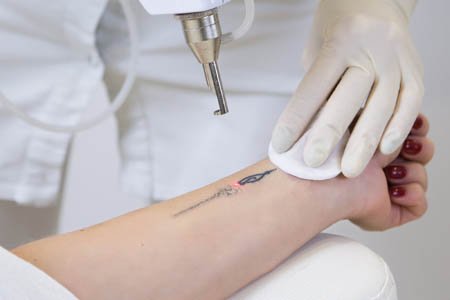
The treatments are performed with the Q-Switch laser, the latest laser technology to erase tattoos.
The laser acts by fragmenting the pigment particles into others of much smaller size that allow our organism to reabsorb them and eliminate them later through lymphatic drainage .
The number of sessions needed to remove tattoos depends on many factors such as color, area, age or depth . The average of sessions for a complete treatment is usually from 8 to 15.
NUMBER OF NECESSARY SESSIONS
FREQUENT DOUBTS OF THE TREATMENT
Some of the factors that influence the number of sessions needed for tattoo removal are:
COLOR OF TATTOO
Pigment of black and dark blue color
They are those that better respond to the laser, and for that reason those that less sessions need for their elimination. The difficulty of this color lies in its high density, as in the case of tribal tattoos.
Color pigment light blue, green, yellow and mixed tones
The absorption peak of these colors and their composition are variable and is mainly conditioned by the amount of titanium oxide or zinc, which are the pigments most difficult to remove.
Pigment of red color
Theyrespond well to the laser although with some sessions more than the black ones.
TYPE OF TATTOO
Professional tattoo
Itrequires a greater number of sessions, from 8 to 15, due to the great permanence of the pigments used and the greater density and depth.
Amateur tattoo
This type of tattoos are made with more unstable inks, so the amount of pigment is less and is usually more superficial. It requires an average of 8 sessions for its elimination although there are times that are deep and will need the same number of sessions as a professional tattoo.
BODY LOCALIZATION
The areas in which the skin is thinner are those that require fewer sessions (head, neck, feminine neckline, wrist).
In areas such as legs, arms and back, the tattoo ink is deeper and the skin is thicker, so they require a greater number of sessions.
SKIN COLOR
In light skins it will be in which the laser responds best and in which the results are noticed with fewer sessions, in the darker skins more sessions will be needed to remove tattoos.
HOW THE TREATMENT IS CARRIED OUT
The treatment is carried out with the Q-Switch laser that combines the wavelengths of 1064nm and 532nm, which eliminates the vast majority of pigments.
The laser parameters are adjusted and the tattoo begins to shoot. The laser acts by fragmenting the particles of pigment into particles of much smaller size that allow our organism to reabsorb them and eliminate them later through lymphatic drainage .
Once the session is over, which is generally fast, thanks to the laser emitting at 5Hz (ie 5 impacts per second), antibiotic ointment is applied and the treated area is covered with an occlusive cure. The cures must be done daily until the skin recovers from the session.
In the course of 4 to 6 weeks our metabolism will eliminate the pigment microparticles. They should not spend more than 8 weeks between sessions, as there are studies that show that the process of tattoo removal slows down.
The Q-Switch laser is very versatile and produces excellent results in the treatment of tattoos. The complications are minimal.
RECOMMENDATIONS PRIOR TO THE SESSION
Do not sunbathe or do UVA sessions 10 days before treatment.
Do not take photosensitive medication: anti-inflammatories (ibuprofen, etc.), antibiotics, stomach protectors (omeprazole), etc.
In case of doubt please consult the specialists of our centers.

Aftercare
Immediately after treatment there will be redness and swelling of the treated area.
It may have a stinging or burning sensation after treatment, usually this sensation subsides a few hours after treatment.
- Apply cold, help reduce discomfort, and reduce swelling and redness.
- Avoid rubbing or scratching the area that has been treated.
- Apply the treatment ointment every 8 hours, from 5 to 7 days.
- Apply a regenerating cream 2 times a day until the healing is complete.
- Try to avoid baths, very hot showers, saunas and hot environments during these days after your treatment.
- Use a neutral soap to wash the treated area. Do not rub or use rough sponges on these areas. Dry with a clean towel by gently pressing on the area and without dragging immediately after washing.
SURGICAL REMOVAL
The resection can be carried out once or in two interventions if the extension is too large, with a parenthesis of three months between the first and the second. The more invasive the intervention, the greater the likelihood that the scar will be visible.
In general, after the operation is a linear scar , slightly longer than the tattoo removed, so it is necessary to take all possible precautions so that the healing occurs correctly at a time when the skin is very tight.
It will be the surgeon who will assess whether he carries out the intervention in two parts or if he opts for alternative solutions , ranging from the use of bioengineering material and skin grafting to the expansion of the dermis before proceeding to the elimination of the tattoo.
The results of these procedures are not always appreciated aesthetically . After the intervention, elastic bandages and special creams based on silicone gel should be used to promote healing.
To determine the indications to follow in the removal of a tattoo is necessary to make an appointment with a plastic surgeon, who will be responsible for providing detailed and personalized information on each case, including time, the method to be followed and the price of the intervention .
